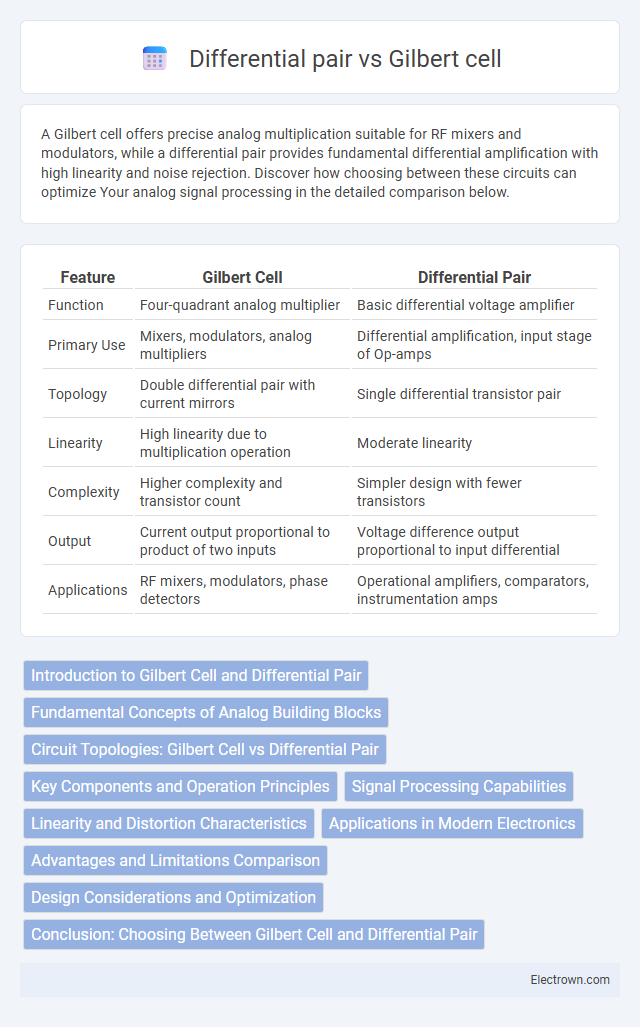A Gilbert cell offers precise analog multiplication suitable for RF mixers and modulators, while a differential pair provides fundamental differential amplification with high linearity and noise rejection. Discover how choosing between these circuits can optimize Your analog signal processing in the detailed comparison below.
Table of Comparison
| Feature | Gilbert Cell | Differential Pair |
|---|---|---|
| Function | Four-quadrant analog multiplier | Basic differential voltage amplifier |
| Primary Use | Mixers, modulators, analog multipliers | Differential amplification, input stage of Op-amps |
| Topology | Double differential pair with current mirrors | Single differential transistor pair |
| Linearity | High linearity due to multiplication operation | Moderate linearity |
| Complexity | Higher complexity and transistor count | Simpler design with fewer transistors |
| Output | Current output proportional to product of two inputs | Voltage difference output proportional to input differential |
| Applications | RF mixers, modulators, phase detectors | Operational amplifiers, comparators, instrumentation amps |
Introduction to Gilbert Cell and Differential Pair
The Gilbert cell and differential pair are fundamental components in analog circuit design used for signal mixing and amplification. A Gilbert cell is a balanced mixer topology that provides high linearity and gain, widely utilized in RF and communication systems. Your choice between a Gilbert cell or differential pair depends on the desired signal processing function, with the differential pair primarily serving as a linear amplifier stage.
Fundamental Concepts of Analog Building Blocks
The Gilbert cell is a versatile analog multiplier using transistors arranged to perform mixing and modulation, critical in RF and communication circuits. The differential pair, a fundamental building block, provides high gain and common-mode noise rejection by converting differential input signals into a single-ended output. Both structures leverage transistor configurations for linearity and gain, with the Gilbert cell focusing on multiplication and the differential pair emphasizing signal amplification and comparison.
Circuit Topologies: Gilbert Cell vs Differential Pair
The Gilbert cell is a complex mixer topology composed of two differential pairs arranged in a transconductance stage and switching stage, enabling frequency mixing and gain. In contrast, a differential pair is a simpler two-transistor configuration primarily used for amplifying differential signals with high linearity and common-mode noise rejection. The Gilbert cell's integrated switching functionality allows it to perform frequency translation, while the differential pair serves as the fundamental building block for analog signal processing and amplification.
Key Components and Operation Principles
The Gilbert cell consists of multiple transistor pairs arranged in a double-balanced mixer structure, using differential pairs for both input and switching stages, enabling multiplication of two signals. Differential pairs operate by comparing input signals and producing an output proportional to their voltage difference, primarily consisting of a pair of matched transistors sharing a tail current source. The Gilbert cell's operation leverages transconductance and switching principles to perform frequency mixing, while a differential pair mainly amplifies differences between two input voltages for signal processing.
Signal Processing Capabilities
The Gilbert cell excels in frequency mixing and amplitude modulation, providing superior linearity and gain control for complex signal processing tasks within communication systems. The differential pair offers high common-mode noise rejection and improved linearity suitable for precise analog amplification and small-signal processing. Gilbert cells are preferred in applications requiring active mixing and gain stages, while differential pairs are more efficient in differential amplification and low-noise signal conditioning.
Linearity and Distortion Characteristics
The Gilbert cell offers superior linearity compared to a differential pair, making it ideal for high-frequency mixers and modulators where signal integrity is critical. Its inherent configuration reduces distortion by providing balanced operation and better common-mode rejection, minimizing intermodulation products. Conversely, differential pairs exhibit higher distortion levels due to non-ideal transistor matching and limited linear range, which affect overall signal fidelity in analog circuits.
Applications in Modern Electronics
Gilbert cells are widely used in modern RF mixers and modulators due to their superior linearity and ability to handle high-frequency signals, making them ideal for communication systems and signal processing. Differential pairs, on the other hand, are fundamental components in analog circuit design for amplifiers, comparators, and operational transconductance amplifiers, providing excellent noise rejection and improved signal integrity. Your choice between these components influences the performance of wireless transceivers, ADCs, and other precision electronic devices.
Advantages and Limitations Comparison
The Gilbert cell offers precise multiplication and better linearity compared to the differential pair, making it ideal for mixers and modulators in RF applications. However, it typically consumes more power and occupies more silicon area, limiting its use in low-power designs. Your choice depends on the need for accuracy versus simplicity, as the differential pair provides lower power consumption and simpler implementation but at the cost of reduced linearity and gain control.
Design Considerations and Optimization
The Gilbert cell and differential pair require careful biasing and matching to optimize linearity and gain in RF and analog circuits. Gilbert cells offer improved multiplication accuracy and higher gain, but demand precise transistor sizing and offset voltage control to minimize distortion and noise. Differential pairs focus on balancing input stage symmetry and minimizing common-mode signals to achieve low noise and high linearity for signal amplification.
Conclusion: Choosing Between Gilbert Cell and Differential Pair
The Gilbert cell offers high gain and superior mixing capabilities, making it ideal for RF and analog signal processing applications. The differential pair excels in simplicity, low power consumption, and better linearity for basic amplification tasks. Your choice depends on whether your design prioritizes complex modulation and high gain (Gilbert cell) or simplicity and power efficiency (differential pair).
Gilbert cell vs differential pair Infographic

 electrown.com
electrown.com